Which Type of Ad Campaign Makes the Most Sense for Your Firm’s Goals?
Zach McDonald
President, Three Crowns Copywriting & Marketing
Search
Subscribe
Successful advertising, like successful financial planning, begins with a goal in mind. In order to establish relevant and realistic goals, you need to first know your current standing.
Often I’ll speak with advisors who want to grow, which is a valid (albeit vague) goal, but it doesn’t help you zero in on an action plan.
When we start talking about what growth would look like for them, the typical response is “more clients, more AUM.” At that point, it’s important to take a few steps back and think through how many other metrics go into getting more clients.
-
What were your clients before they became clients? Leads.
-
What were your leads before they became leads? Website visitors.
-
What were your website visitors before they became visitors? Strangers on the internet.
In order to get more clients, you need more leads, which means you need more website visitors, which means you ultimately need to get those strangers on the internet to somehow find their way to your site.
Today I want to talk about which campaigns are available to you, which make the most sense based on your goals, and how you can get started. Be sure to stick around, because I’ll be sharing my go-to formula to help advisors get a good start in the world of digital advertising.
(If you want that go-to formula right now, you can grab it here.)
We can break ad campaign types into three stages defined by their goals:
-
Awareness
Turn those strangers into website visitors. This is the main building block for increasing your leads. -
Retargeting
Turn those website visitors into repeat visitors, increasing their likelihood of becoming leads. -
Lead generation
Turn those visitors into leads. This is the end goal of digital advertising for financial advisors.
But before we jump right into it, let’s look at how you can tell which goal is right for you.
One of the most important (and ignored) steps in determining what kind of advertising campaign you want to run is to look at your site’s analytics. How many people visit your site? If it’s a decent number, then good for you! You are at the visitors stage! But if your website isn’t pulling in at least 100 people a day, you should probably begin at the beginning.
So let’s do that now…
Awareness Campaigns
In order to get more people onto your website, you have to tell more people about who you are and what you do. “Awareness campaign” is a bit of a lackluster industry term – I like to refer to these as “traffic-boosting campaigns,” because that’s exactly what they’re designed to do: boost traffic on your website. But we’ll stick with awareness campaign, since that’s the parlance of our times.
The metrics that matter most differ between campaign types. Awareness ads are used to promote your latest article, or just drive people to your homepage, so you’re not necessarily expecting conversions out of your campaign.
Instead, you’re going to want to look at the following metrics when running awareness campaigns:
-
# of clicks
-
Clickthrough rate
-
Bounce rate
-
Time on page
How you track these metrics is a topic for another article entirely, but in short, the first two can be found in your advertising channel of choice, and the last two are found in your analytics platform.
You can run awareness ads on several channels, but we’ll just do a quick overview of the two that I have found to be the most effective (both in terms of impact and cost) for financial advisors:
1. Facebook
A lot of marketers talk about the “marketing funnel,” which is a visualization of the process of turning strangers into leads.
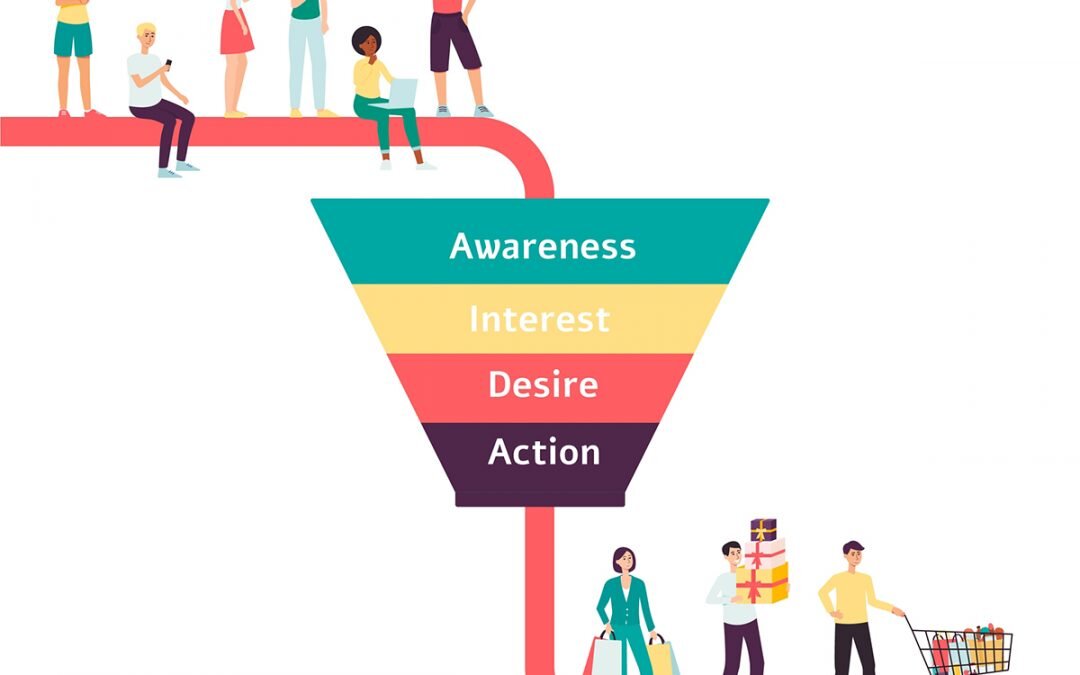
Image credit: FunnelKake
The main way I like to use awareness ads on Facebook is to point people to the best article on your website, then retarget them with different pieces of content until they convert on a lead ad. The reason I say to use your best article is because, for a lot of people, this will be their first impression of you if they’re right at the top of the funnel. In order for them to continue through Interest, Desire, and Action, you need to present your firm in the most favorable light.
Of course, you’ll want to run ads for other articles too. Have you heard of the Rule of Seven? It says that most consumers will need to have seven positive interactions with your brand within an 18-month period before they will take an action. That rule has been around longer than the internet, and some people say it’s more like the Rule of 21 with all the ads and brands people see on a daily basis (some estimates put that number at about 5,000 per day).
So on Facebook, run ads for your best article. Then run ads for your second best article. Then run ads for the best page on your website. Then retarget everyone who has hit your website with other ads (more on that in just a minute).
2. Search Ads
Everybody knows search ads – they’re those things you skip at the beginning of search results, right? While up to 80% of people say they ignore search ads, you can’t argue with results. With more than 160 billion searches every month on Google alone, that remaining 20% of users is nothing to sneeze at.
Search ads are especially useful if you’re struggling to rank for “financial advisor [my city].” While you work on fighting your way to the front page through digital and content marketing, you can rent a spot right at the top of the first page. And even when you make it to the top of page one, many companies still choose to pay for that spot, just in case.

Search ads can have more than one link. The main link typically points to your homepage (as in the example above), and then you can add sitelink extensions to pages you think people will likely want to see, as in the example below:
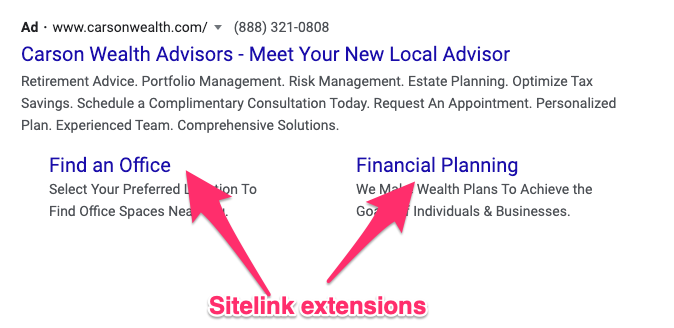
So remember the difference between these two channels: Facebook awareness ads point to articles, search ads points to pages (of course there are exceptions, but that’s a good rule of thumb to live by). The reason for this is simple (I’m paraphrasing Andy Crestodina here): When someone is searching for something, they’re busy. When they’re on social media, they’re bored.
To pull people off of social, you have to give them something engaging enough that they’ll give up some of their downtime for. To pull them from search, you have to give them what they’re looking for.
In summary, the two channels you should be running awareness campaigns on are Facebook and Google. After awareness, we move on to lead generation campaigns.
Lead Generation Campaigns
The purpose of lead generation campaigns is right in the name: to generate leads. When someone clicks on a lead generation ad (or “lead gen,” in Marketingspeak), they’re going to be asked to provide personal information in exchange for a resource of some sort.
If you had the choice between running a campaign aimed at bringing in leads or increasing traffic to your website, which would you choose? All things being equal, of course you’d choose to generate leads. But for most advisors, all things aren’t equal.
Think back to the funnel we looked at earlier – the first step was awareness. Sure, you can leapfrog that first step, but you’ll find that your funnel is not sufficiently full at some point. But perhaps most importantly, by laying the groundwork with awareness campaigns, you can allow your site’s pixel to learn more about your target audience so when you do run a lead gen campaign, you’re targeting is much more focused.
Common resources used in lead gen campaigns include (but are definitely not limited to):
-
Ebooks
-
Webinars
-
Demos
-
Fact sheets
-
Newsletter subscriptions
-
Calculators
The destination for a lead gen campaign is usually a landing page on your website, but depending on which channel you’re advertising on, you may be able to also use a pop-up form (more in a minute).
The most important metric on a lead gen campaign is conversions, or leads. After that, you’ll also want to keep an eye on conversion rate and cost per conversion.
If your conversion rate is super low (meaning a lot of people are clicking your ad and then not filling out the form), then you may want to look at your landing page/form to make sure it’s optimized. Is the messaging clear? Is the form immediately visible when they land on the page? What could be confusing/turning off website visitors?
The 3 Hard Truths of Lead Gen Campaigns for Advisors
I’ve run a lot of lead gen campaigns for advisors, and the biggest obstacle is often accepting this fact: When you’re looking at running a lead gen campaign, not every person who converts is going to be an ideal client.
The targeting is not quite an exact science. For instance, Facebook allows you to target based on household income and they break it out into four categories:
-
Top 5% of zip codes
-
Top 10% of zip codes
-
Top 10 to 25% of zip codes
-
Top 25 to 50% of zip codes
I don’t know about you, but I never sent any of my W-2s to Facebook, so they don’t really know this one for certain. Of course, with all the data they’ve collected, Team Zuck probably has the best chance of anyone of being right with an educated guess about how much anyone makes, but that doesn’t mean they’re always going to get it right.
In addition, thanks to Facebook’s News Feed algorithm, if someone likes or shares your ad, then some of their non-qualified friends could end up filling out the form.
On top of that, not every lead who fills out your form is going to be ready to work with an advisor, or want to leave their current advisor, or any of the other countless reasons a lead turns into a dead end.
I say all this to make one thing clear: Lead gen campaigns do not turn into a bunch of consultations, especially in the short term. Once you have a lead’s information, then you should plug them into your current marketing efforts and let it play out.
The three hard truths of lead gen campaigns for advisors that most marketers like to gloss over:
-
For every one good lead, expect at least two bad leads – This can be a tough pill for advisors to swallow. Michael Kitces found that advisors tend to avoid using tactics that require them to sift through bad leads to find the good, so it’s important to recognize that this is the reality of lead gen campaigns.
-
At some point, you will pay $50 or more for a lead who gives you fake contact info – Leads can be expensive, but they can also be cheap. Wordstream puts the industry average cost per action at $41.43 for the financial industry, but I’ve seen that number reach above $100. And some of those leads will tell you their email is batmanandrobin@dynamic.duo and their phone number is 867-5309. It happens.
-
Results are not guaranteed – I have run the exact same campaigns for firms across the country and seen a range of 2 to 40 leads in the course of a month between different firms in comparably-sized cities.
All that to say that setting expectations is incredibly important when launching a lead gen campaign.
I’ll just cover one channel for lead gen campaigns because it’s a great place to test them out and figure out if they’ll work for you: Facebook.
Facebook Lead Gen Campaigns
Facebook allows you to run lead ads in two ways:
-
Point people who click to a landing page on your website
-
Use a pop-up form provided by Facebook (this option is known as Facebook Lead Ads – I’ll refer to the by FLA to try to avoid confusion between Lead Ads and lead gen)
FLA are one of my favorite ways to run lead gen campaigns. Conversion rates are affected by a lot of factors on landing pages, including load speed, design, messaging and much more. FLA avoids that entirely by just doing everything in a pop-up form in Facebook.
We’re currently running an ad campaign for our free Zoom backgrounds for advisors using FLA, and here’s what our form looks like:

I love it – clean, simple, efficient.
One of my favorite tactics for using lead gen campaigns on Facebook is to target an audience you’ve already interacted with in some way – maybe they clicked one of your awareness campaigns or visited your website. By the time they give you their contact info and turn into a real lead, they’ve already interacted with your brand a couple times, so it helps qualify them a little bit more. This tactic only works if you’re retargeting pretty big audiences.
And now on to our final campaign type:
Retargeting Campaigns
I saved retargeting ads for last because they can be used for awareness purposes or lead-gen, and I’ve seen advisors do both successfully.
Have you ever looked at a pair of shoes on Zappos and then you see ads for that exact pair of shoes everywhere for the next month? As annoying as it can be, it can also be incredibly effective. People who see retargeting ads are up to 70% more likely to convert in the end than those who don’t.
Of course, it’s paid promotion, so there’s still going :
-
Ad fraud is rampant, and you will end up paying for some bot clicks – Even with fraud protection software, “There are no 0 percent fraud campaigns,” according to ad fraud specialist Dr. Augustine Fou. How much fraud should you expect? Ad fraud detection company ClickCease says roughly 20%, while Fou’s assessment is much more bleak: “Between 1 and 100 percent.”
My two favorite channels for retargeting campaigns are AdRoll and Facebook.
Retargeting Ads on AdRoll
AdRoll is the king of retargeting ads. Your ads can display on pretty much any website that allows ads, including news sites, blogs, social media sites and more. Whether you realize it or not, you’ve seen them before. Here’s an example of one of AdRoll’s own ads on the Weather Channel’s site.
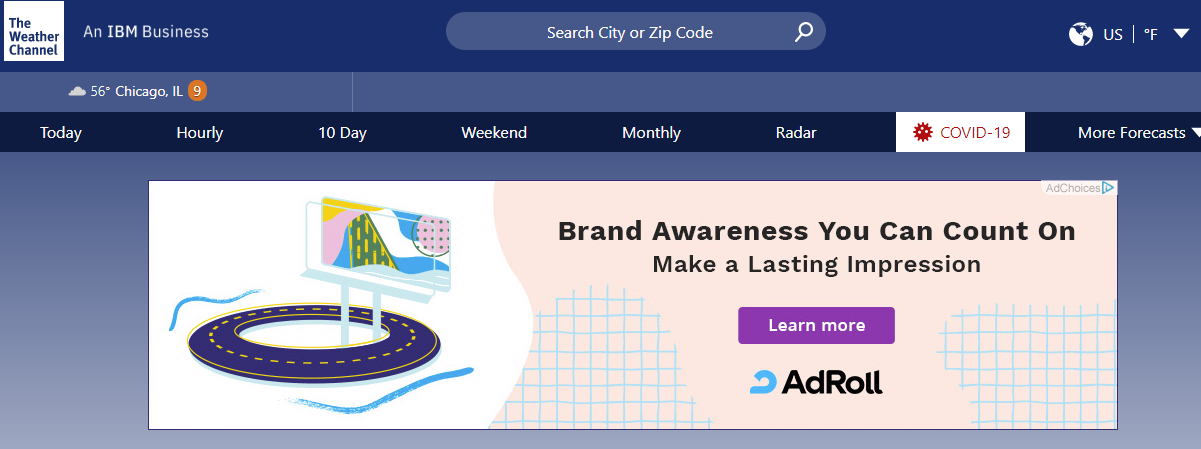
Retargeting Ads on Facebook
Facebook’s retargeting ads can look just like awareness ads – the only difference is who they’re targeting. If you have your Facebook Pixel installed on your website, you can target anyone who visits your website, or just people who visit a particular page.
In order to properly run a retargeting campaign on Facebook, you want to have an audience of at least 1,000. Facebook struggles to properly serve ads to audiences smaller than that.
Why I Didn’t Mention Linkedin or Twitter
You may have noticed that I didn’t mention some other advertising channels. That doesn’t necessarily mean you should avoid them, but I will tell you two things:
-
Advertising on Linkedin is considerably more expensive than Facebook
-
Targeting the right audience on Twitter is harder, especially for financial advisors – plus, in my experience, advertising on Twitter results in much higher bot activity than other channels.
Six-Month Starter Formula for Advisors Wanting to Try Advertising
If you want to test advertising and see how it works for you, here’s a plan to help give your efforts a little direction.
One important note: These are just suggestions. Keep a close eye on your results. If your cost per click or conversion gets super high, consider tweaking your targeting or messaging. Also, if the budget feels too big or too small, it can be tweaked. Just keep in mind – there’s a direct correlation between how much you spend and the results you get. The budgets suggested below are the minimum you should expect to spend for real results.
Second important note: Make sure you install all the necessary pixels (from Facebook and AdRoll) upfront before doing anything else.
Third note (last one, I promise): If you’re going to do this right, you’ll want to refer back to this information, so we put it all together for you in a downloadable sheet here.
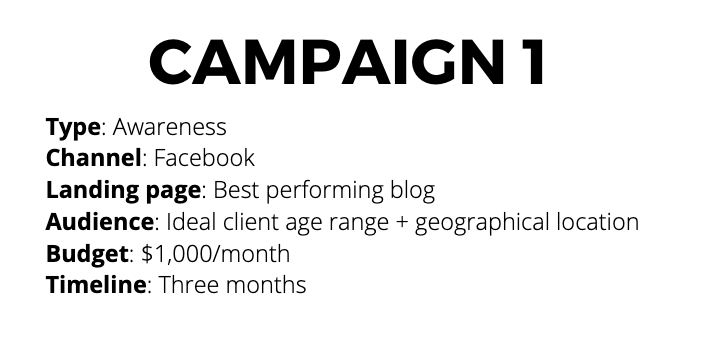
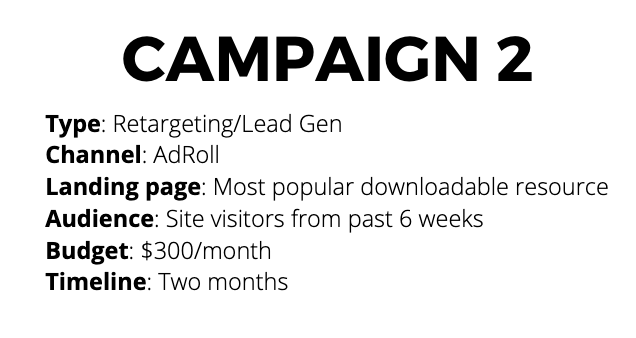
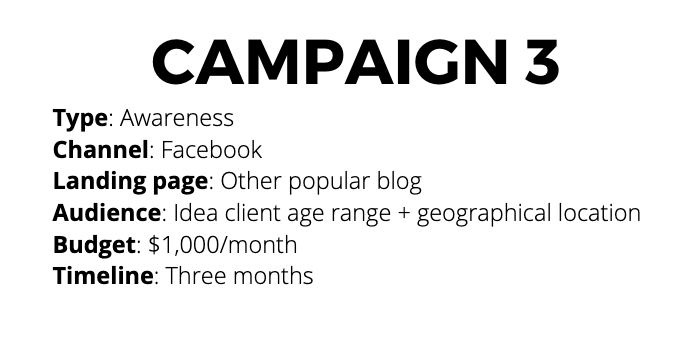
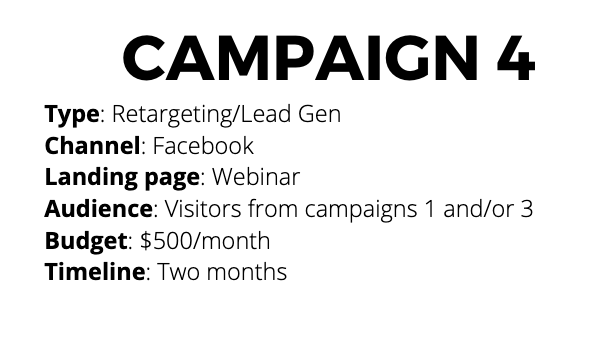
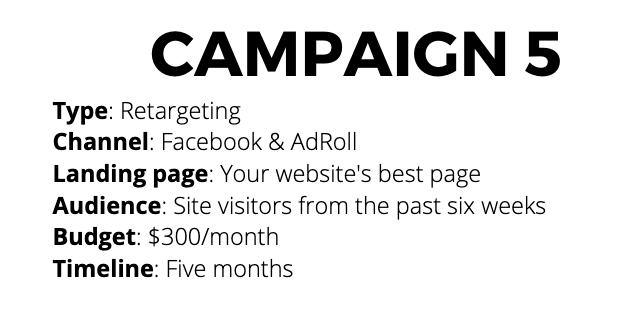
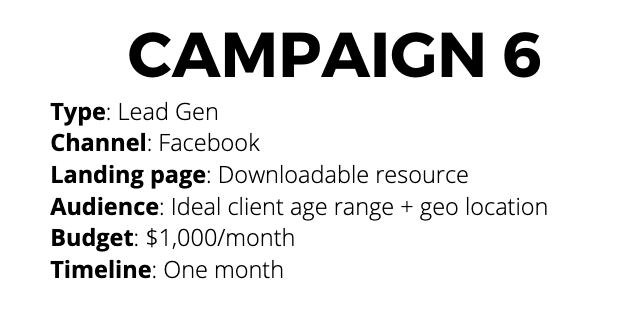
Wrapping Up
That does it for advertising for financial advisors. So what’s your goal? Which campaign are you going to try?
Want to talk about where you should start? Click here to schedule a consultation with me. We can talk through your goals and what makes the most sense for you.